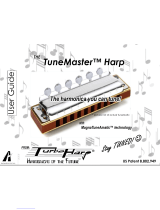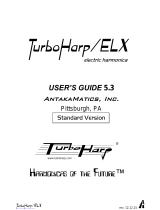Page is loading ...

Plate Reed
Two-third of reed length
The reed is curved from
two-thirds of the length of the reed.
Length of reed
Plate Reed
• Reed clearance is too high | Feeling of air leakage.
• Reed clearance is normal.
•
Reed clearance is made at the tip of the reed | It can make a muffled sound.
•
Reed clearance is too low | If blowing a little hard, the sound will be blocked and will not sound.
•
Reed clearance is made from the root of the reed | Feels like air leakage.
Clearance
For daily maintenance of your Harmonica, it is enough to remove moisture
and keep the mouth piece clean and dry. We recommend MIC-30 Suzuki
Micro Fiber Cleaning Cloth. If particles accumulate inside the instrument after
long-term use, disassemble it as shown in the diagram and clean it. The
disassembled plastic body can also be washed with water. Since the reeds
are delicate, handle with the utmost care so as not to snag or bend. Wipe off
the mouth piece by spraying with a Harmonica cleaner on a soft lint free cloth.
Upper cover
Lower cover
Screw for reedplate
Upper reedplate
Lower reedplate
Body
Nut for cover plate
Screw for cover plate
It is important to re-assemble the Harmonica so that there are no gaps
in each part. Carefully check the body and reed plate, reed plate and
cover, etc., and re-assemble so that there are no gaps due to particles
or misalignment. The reed plate and cover are slightly curved so that
they can be assembled without gaps.
Clearance
Maintenance may be required on your Harmonica after a certain period of use.
Adjustments tailored to each player will become indispensable for refining
performance. The HRT-01 is a basic tool set that takes portability into
consideration, so all normal maintenance other than reed replacement is
possible. It is recommended that you obtain knowledge of basic maintenance and
-if possible- some training from a skilled professional. It is better to practice with a
broken or low cost Harmonica at first, before starting maintenance on a more
expensive model.Once you understand the basics, it may be easier than you think.
SUZUKI HARMONICA REPAIR TOOL SET
Wrench / Spanner
Used to adjust the
position of the reed.
Flat head fine grade file
Use for tuning. File at
base of reed to tune
down.
Screwdriver(+,–)
Used for attaching and
detaching screws.
Spatula
A basic tool and is
used for various
tasks.
Midium/Coarse File
Used for tuning. File
a head of reed to
tune up.
Harmonica cleaning
Cleaning
The reed has a gap called 'reed clearance' for the air to flow. Bass
requires more air to flow slowly, so the clearance is higher. The treble
requires the air to flow quickly and more forcefully, lowering the clearance.
If the clearance is too low, it is easy to get stuck at the beginning of the
response, and if it is too high, it can feel like air leakage. It will be possible
to adjust the clearance to suit the performer.
Adjustment of the reed clearance
Reed
tuning
Adjust the
position of
reed
Before use
• Please be advised that this tool kit is not suitable for all Harmonicas.
• It is recommended that you work in a quiet place without interruption, to focus
your full attention.
• Generally parts will have limitations in durability.
• We are not responsible for any damage or injury resulting from the use of this
product. Please make sure that you understand the instructions before using.
Caution
CONTENTS
Bass
Middle
Treble
Main maintenance
Reed
clearance
tuning
Example of reed clearance
Use a spatula to adjust the clearance to your preference.
Push up the reed as if stroking with a spatula.
Push down the
reed with a spatula.
Push down the reed as if stroking with a spatula
When making the clearance higher.
Push up the reed as if
stroking with a spatula
When making the clearance lower.
It is possible to raise, by shaving the tip of the reed thinly using the medium/coarse file.
Once you have learned how to shave
reeds, you can progress to tuning.
When making the pitch higher.
When making the pitch lower.
Learn how to shave reeds before tuning the reeds.
The pitch can be lowered by shaving the root
of the reed in the direction of the arrow with
the flat head fine grade file.
Spatula
Midium
/Coarse
File
Shave the root with the flat
head fine grade file.
Hold as close to the blowing
sound as possible and check
the sound one by one.
Inside the reed(draw note)
Outside the reed(draw note)
Flat head fine grade file
Reed contacts plate
Remove cover
After confirming notes to be checked, remove the cover as shown in
diagram 1 (image is a Tremolo Harmonica, but think about other
Harmonicas in the same way.)
Check sound
Use a Tuner (preferably one that can read the pitch in 1 cent units) to
tune while checking the out of tuned notes, with the cover removed. At
this time, if you do not check the sound by firmly pressing the air outlet
side up and down, as in diagram 2, the sound will change when the
cover is attached. If you are having trouble blowing through in this
state, please check the sound with the cover on. For tremolo
Harmonicas, you need to check the upper and lower reeds separately.
If it is not easy to check notes at the top and bottom separately, please
hold the reed on one side with your other hand so that only one side
sounds and you can check the pitch.
Shave the tip with
Midium/Coarse
File
Since shaving
burrs remain on
the shaving
part, arrange it
with the file.
Since shaving
burrs remain on
the shaving
part, arrange it
with the file.
Since shaving
burrs remain on
the shaving
part, arrange it
with the file.
The reeds are attached to the plate with very little clearance. Due to
disassembly or re-assembly, the reed position may move and the reed may
come into contact with the plate and the sound may not be heard correctly. In
this case, use the spanner to correct the reed position as shown below.
Holding it over a bright light makes it easier to see this slight gap.
Reed tuning
Adjust the position of reed.
Flat head
fine grade
file
Spatula
Normal reed position
How to shave reed
How to tune reed
When tuning draw notes.
As shown in diagram 3 (cross section view) the drawn reed is attached
to the outside, so tune it according to the procedure of 'How to shave
reeds'.
<When making note lower>
Shave the base on the back of the reed from outside with the flat
head fine grade file.
When tuning blow notes.
<When making note higher>
As in diagram 4, use a spatula to push the reed up and lodge
the reverse end of the spanner under the reed and use the
medium/coarse file to shave the tip of the reed.
Diagram 1
Diagram 3
Diagram 4
Diagram 2
Reed
Frame for reed
Head of reed
Secure the head
of reed with a
wrench/spanner.
Move the
wrench/spanner
in the direction of
the arrow to return
the reed to the
normal position.
Wrench
/Spanner
Caution: if there is too much movement on a reed, it may detach or
fracture, so care is needed.
Caution: Please check again as the clearance may change after tuning
• Inside the reed
• Outside the reed
SUZUKI MUSICAL INSTRUMENT MFG. Co., Ltd.
2-25-7, Ryoke, Naka-ku, Hamamatsu, Shizuoka Pref. 430-0852 JAPAN
/

